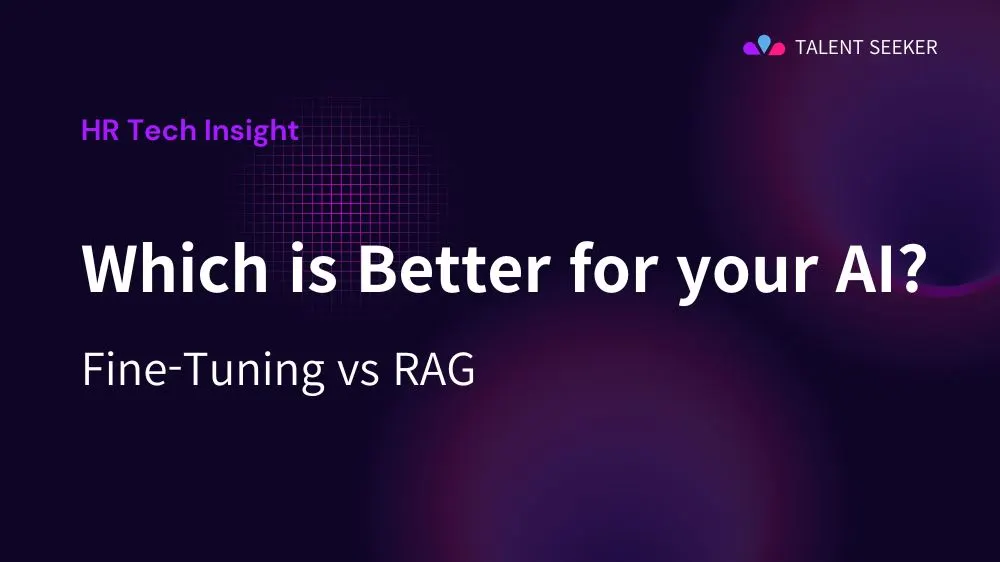Introduction
As artificial intelligence (AI) continues to reshape how we work, build products, and make decisions, organizations are looking for ways to tailor general-purpose language models to domain-specific use cases. In a previous article, we examined Instruction Tuning, a flexible method that allows models to follow natural language instructions without requiring massive retraining.
In this article, we explore two powerful yet fundamentally different approaches to customizing AI systems: Fine-Tuning and Retrieval-Augmented Generation (RAG). While both are used to specialize large language models (LLMs), they operate on different principles. Understanding their trade-offs is critical for building effective AI solutions in domains such as HR Tech, legal, and healthcare.
What is Fine-Tuning?
Fine-tuning is a method of adapting a pre-trained language model to a specific task or domain by continuing its training on labeled datasets. The model’s internal parameters (weights) are updated so that it performs better on the new task. For example, in an HR use case, a model can be fine-tuned on thousands of anonymized resumes to improve candidate-job matching accuracy. The diagram below illustrates this process: starting with domain-specific data, the information is structured and used to further train the pre-trained model. Through this additional training, the model’s weights are adjusted, enabling it to specialize in the new domain and deliver more accurate, task-specific results. This cycle can be repeated as more data becomes available, allowing the model to continuously improve and adapt to evolving requirements.
Open AI, Fine-Tuning (Image Reference-https://platform.openai.com/docs/guides/fine-tuning)
How Fine-Tuning Works
1.
Data Preparation: Domain-specific or task-specific labeled datasets are prepared.
2.
Model Training: The pre-trained model is updated using gradient-based learning to adjust its weights.
3.
Validation: Performance is measured on unseen examples to ensure overfitting is avoided.
Fine-tuning leads to a model that behaves differently from the original base model, becoming specialized to the training data.
What is Retrieval-Augmented Generation (RAG)?
Retrieval-Augmented Generation (RAG) enhances LLMs by combining them with an external knowledge base. Instead of depending solely on what the model “remembers,” RAG retrieves relevant information in real time and injects it into the prompt before generating a response.
This approach is particularly useful for domains where up-to-date or detailed information is essential. For example, an HR assistant built with RAG could retrieve the latest labor regulations or employee handbook policies before answering user queries.
The following diagram presents a conceptual flow of using RAG (Retrieval-Augmented Generation) with an LLM, numbered in the correct order.
AWS, What is the RAG? (Image Reference-https://aws.amazon.com/what-is/retrieval-augmented-generation/)
How RAG Works
1.
Retrieval Step: Given a user query, the system searches a knowledge base (e.g., internal company documents) for relevant documents.
2.
Augmentation Step: The retrieved documents are appended to the query and fed into the LLM.
3.
Generation Step: The model generates a response using both the query and the retrieved content.
Because the model isn’t retrained, it remains general-purpose but behaves as if it were domain-aware.
Differences Between Fine-Tuning and RAG
Aspect | Fine-Tuning | Retrieval-Augmented Generation (RAG) |
Core Idea | Modify model weights | Inject external knowledge dynamically |
Data Requirements | Requires labeled training data | Requires a high-quality knowledge base |
Adaptability | Highly specialized to trained tasks | General-purpose with flexible knowledge access |
Maintenance | Needs retraining to update knowledge | Updates instantly by modifying documents |
Example Use Cases | Resume classification, skills extraction | Policy Q&A, real-time compliance assistant |
Benefits and Limitations of Fine-Tuning
Benefits
1.
High Accuracy: Performs well on repetitive, structured tasks.
2.
Efficiency at Inference: No need for document search; fast inference.
3.
Domain Specialization: Learns patterns deeply from in-domain examples.
Limitations
1.
Expensive Training: Requires compute and time.
2.
Static Knowledge: Needs retraining when domain data changes.
3.
Risk of Overfitting: Especially if data is small or noisy.
Benefits and Limitations of RAG
Benefits
1.
Knowledge Freshness: Accesses latest information in real-time.
2.
Less Training Needed: No need to change model weights.
3.
Explainability: Retrieved content can be shown alongside output.
Limitations
1.
Retrieval Quality Dependency: Poor search leads to poor generation.
2.
Latency: Slightly slower due to retrieval step.
3.
Complex Infrastructure: Requires document indexing, embeddings, and search pipelines.
When to Use What?
Context | Recommended Approach |
You have large labeled datasets and a fixed task | Fine-Tuning |
You need to reflect fast-changing information | RAG |
You require explainable, document-backed answers | RAG |
You need compact, high-speed model deployment | Fine-Tuning |
You work in regulated or high-risk environments where every answer must cite a source | RAG |
Next Article Preview: AI Agents in Action
In the next article, we will explore how AI Agents, modular and autonomous units powered by specialized models, are transforming enterprise workflows. From resume screening bots to policy advisors and team collaboration assistants, AI agents can interact with one another, make decisions, and delegate tasks across complex pipelines.
We’ll discuss how Fine-Tuning and RAG each play roles in building such agents, what it takes to orchestrate them effectively, and how agent-based architectures are shaping the next wave of intelligent automation in HR Tech and beyond.
Stay tuned as we dive into how agents think, talk, and collaborate, and why this could be the most transformative shift in AI since the advent of large language models.
References
•
Lewis, P. et al. (2020). Retrieval-augmented generation for knowledge-intensive NLP tasks. arXiv:2005.11401
•
Raffel, C. et al. (2020). Exploring the limits of transfer learning with a unified text-to-text transformer. JMLR
•
OpenAI. (2023). Fine-Tuning Guide for GPT Models





